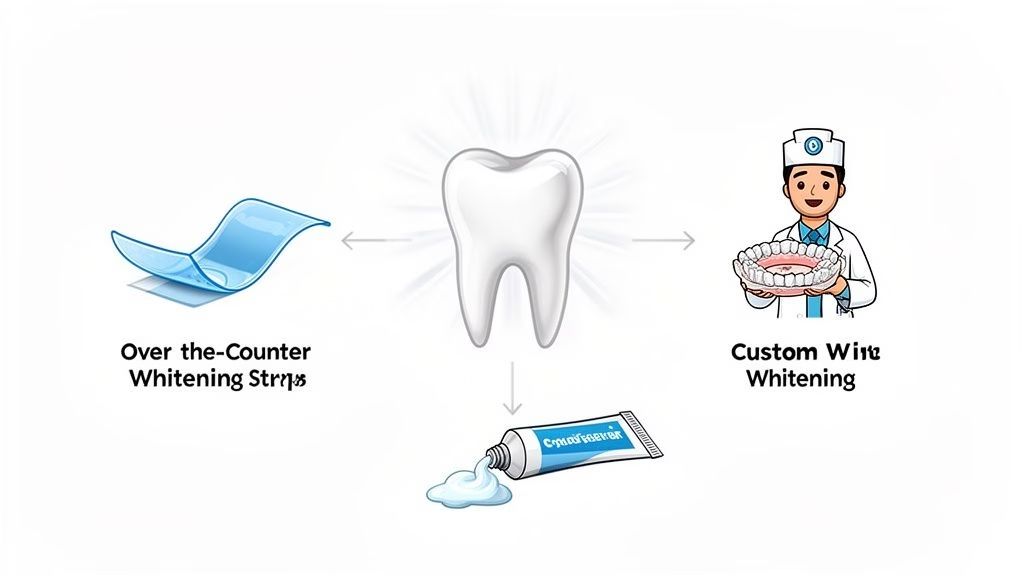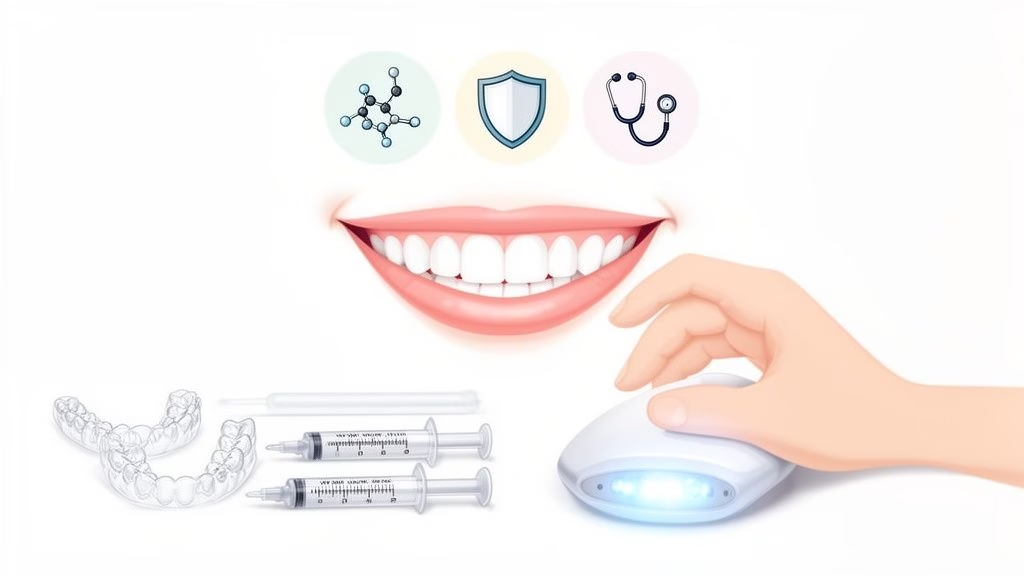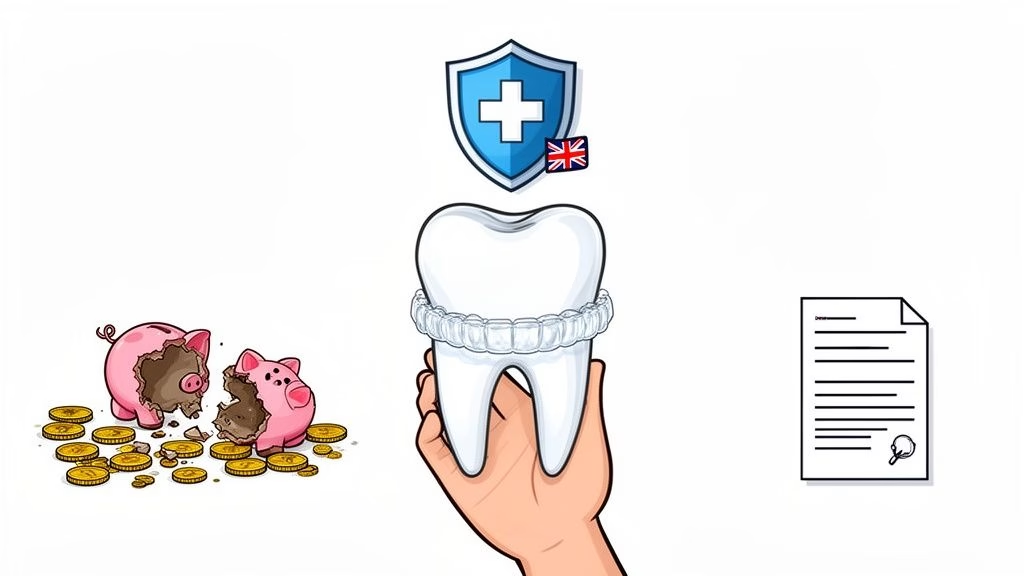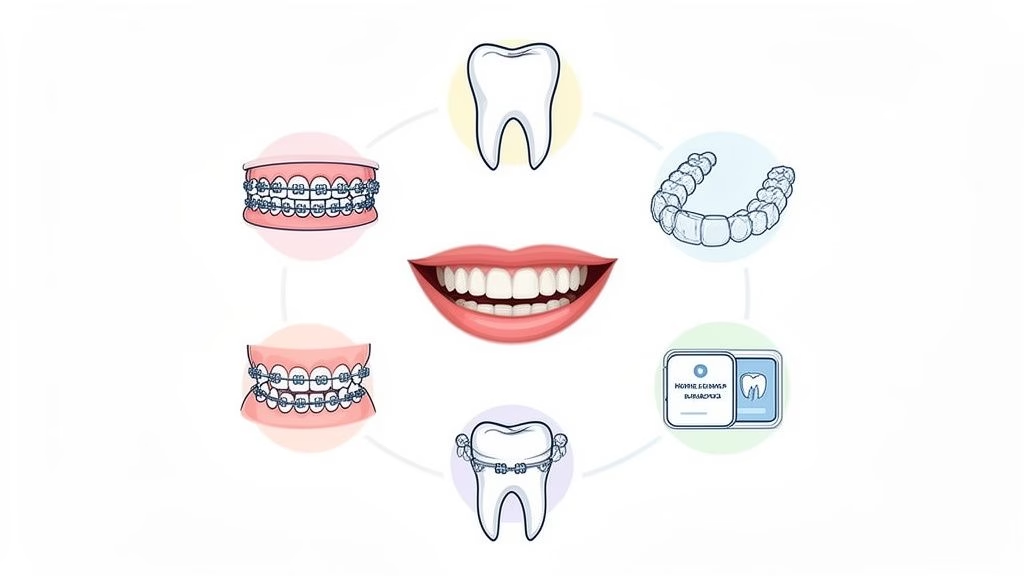What Is Fluoride Treatment? Benefits & How It Protects Your Teeth

When you visit your dentist, you might hear them mention a fluoride treatment. It’s a straightforward and painless procedure where a highly concentrated form of fluoride, a naturally occurring mineral, is applied directly to your teeth. Think of it as a powerful, protective shield for your smile.
This simple, non-invasive treatment is one of the most effective ways to strengthen your tooth enamel and make it far more resistant to decay.
How Does Fluoride Treatment Actually Work?

Let’s use an analogy. Imagine your tooth enamel is a sturdy brick wall. Every day, acids from foods, sugary drinks, and plaque act like corrosive forces, slowly chipping away at the minerals in that wall. This process of mineral loss is called demineralisation, and it weakens your teeth and eventually leads to cavities.
A professional fluoride treatment acts like a specialist repair team for that wall. It works at a microscopic level to restore essential minerals to enamel. This restorative process is known as remineralisation.
The fluoride doesn’t just patch up the holes; it integrates into the enamel’s structure, forming a new, much stronger surface called fluorapatite. This fortified enamel is significantly tougher and better equipped to fend off future acid attacks.
So, when we talk about fluoride treatment, it’s not just a temporary coating. It’s a fundamental process that boosts your teeth’s natural defence system from the inside out.
To give you a clearer picture, here is a quick summary of what fluoride treatment involves and its primary benefits.
Key Aspects of Fluoride Treatment at a Glance
| Aspect | Description |
|---|---|
| Primary Goal | To strengthen tooth enamel and prevent cavities. |
| Mechanism | Replenishes lost minerals (remineralisation) to fight acid damage. |
| Key Benefit | Creates a more acid-resistant tooth surface (fluorapatite). |
| Outcome | Can reverse the very earliest signs of tooth decay. |
| Procedure Type | Non-invasive and professionally applied by a dental expert. |
This table shows how fluoride treatment is a proactive and restorative measure, not just a preventive one.
More Than Just Prevention: It’s the First Step to a Better Smile
Here’s something many people don’t realise: fluoride doesn’t just prevent new problems. It can actively reverse the earliest stages of tooth decay, stopping tiny weak spots from developing into full-blown cavities that would need a filling. This treatment lays a vital foundation for your long-term dental health by halting decay before it truly begins.
This foundation is crucial, especially if you’re thinking about cosmetic procedures like teeth straightening. You need a strong, healthy base before making any aesthetic changes. Toothfairy offers a smarter way to integrate this essential preventative care with your cosmetic goals, including more affordable teeth straightening. They help ensure your journey to a straighter smile is built on solid ground, preventing potential issues with aligners or other treatments down the road. It’s about putting health first to get the best possible results.
Exploring Different Types of Fluoride Treatments
When your dentist suggests a fluoride treatment, it’s not a one-size-fits-all deal. Think of it more like a tailored prescription. There are a few different ways to get this brilliant mineral onto your teeth, and your dentist will pick the method that makes the most sense for your oral health.
Knowing a bit about these options means you can have a much more confident chat about your care plan. The most common applications happen right there in the dental chair, using professional-strength fluoride for the biggest impact.
In-Office Professional Treatments
Your dentist or hygienist has a couple of highly effective tools in their kit:
- Fluoride Varnish: This is exactly what it sounds like – a sticky, paint-on varnish. Using a small brush, your dentist will apply a thin layer directly onto your teeth. It sets almost instantly when it touches saliva and stays put for several hours, giving your teeth a prolonged, intensive dose of fluoride.
- Fluoride Gels and Foams: For this method, you’ll be given a soft, flexible tray (a bit like a mouthguard) filled with a fluoride gel or foam. You simply bite down and keep the tray in your mouth for a few minutes. It’s a great way to make sure every nook and cranny of your teeth gets a thorough coating.
So, which one is for you? It often comes down to your age, your risk of cavities, and even just personal preference. Varnish is a popular choice for young children, for example, because it’s so quick and easy to apply. Either way, it’s a simple, painless step to strengthen your enamel.
Broader Fluoride Exposure
Of course, the dental clinic isn’t the only place we find fluoride. It’s a key player in public health, most notably through community water fluoridation. This provides a low, steady level of exposure that helps strengthen teeth across entire populations. However, not everyone in the UK gets it.
In England, access to optimally fluoridated water varies quite a bit depending on where you live. While about 10% of the population has water with fluoride levels considered ideal for dental health, nearly 40% receive water with very low fluoride. This really highlights why professional treatments are so important. You can dig into the specifics in the government’s health monitoring report on water fluoridation in England.
This image sums up how these treatments work to protect your teeth.

As you can see, fluoride’s main jobs are to strengthen your enamel, help prevent cavities from forming, and reduce tooth sensitivity. For anyone at a higher risk of decay, dentists might also prescribe a high-strength fluoride toothpaste or mouth rinse to use at home, giving you an extra layer of protection between visits.
The Real Benefits of Professional Fluoride Treatments

When we think of fluoride, we usually think of preventing cavities. And while that’s true, the advantages of a professional fluoride treatment run much deeper, actively improving your overall dental health and even saving you money in the long run.
One of its most impressive feats is the ability to turn back the clock on the very earliest stages of tooth decay. It works by replenishing lost minerals, essentially healing microscopic weak spots in your enamel before they have a chance to develop into full-blown cavities that need a filling.
This proactive repair work means you can often avoid more invasive and costly dental procedures down the line. It’s a small investment in prevention that pays huge dividends for your long-term health.
Fluoride treatments are also a game-changer for anyone dealing with tooth sensitivity. If you find yourself wincing at the thought of a cold drink or a spoonful of ice cream, it might be due to exposed root surfaces. Fluoride helps build a protective barrier over these vulnerable areas, drastically reducing that sharp, sudden discomfort.
A Foundation for Future Smile Goals
Think of fluoride as creating the perfect, solid foundation for any other dental work you might be considering. Whether you’re dreaming of cosmetic enhancements or straighter teeth, starting with a healthy, resilient smile is non-negotiable. For instance, before you even think about starting a journey with clear aligners, you need to ensure your teeth are strong and free from decay.
This is where planning your dental journey intelligently really pays off. With Toothfairy, you can connect vital preventive care, like fluoride treatments, with smarter, more affordable teeth-straightening solutions. By putting the health of your teeth first, you’re making sure any cosmetic work is built to last, leading to better, more sustainable results for your dream smile. It’s simply the smartest way to approach your dental health.
Right, let’s break down what actually happens when you sit in the dental chair for a fluoride treatment. If you’re feeling a bit nervous, don’t be. It’s genuinely one of the simplest and quickest things we do in preventative dentistry, and it’s completely painless.
So, how do we get that protective fluoride onto your teeth? It usually comes down to one of two methods, and your dentist or hygienist will pick the best one for you.
- Fluoride Varnish: This is the most common approach these days. We use a small, soft brush to paint a sticky varnish directly onto your teeth. It feels a bit like painting your nails, but for your smile! The varnish sets in seconds and starts working its magic straight away.
- Fluoride Gel or Foam: The other option involves a soft, squishy tray that looks a bit like a mouthguard. We fill this with a fluoride gel or foam, and you simply bite into it and hold it in your mouth for a few minutes. It’s an easy way to give all your teeth an even coating.
After the Treatment: What You Need to Do
The application itself is over in a flash, usually just a couple of minutes. The real key to success is what you do immediately afterwards.
We’ll ask you to avoid eating or drinking for about 30 minutes. This little waiting game is crucial because it gives the fluoride enough time to properly absorb into your tooth enamel, locking in that protective benefit.
This isn’t some niche procedure; it’s a cornerstone of preventative care, especially for kids. To give you an idea of how routine it is, fluoride varnish application was part of 56% of all NHS dental treatments for children in England during 2023-24. It’s a clear sign of just how vital this simple treatment is for protecting young teeth, a fact supported by the latest NHS dental statistics. You can read more about these findings on NHS dental care for children if you’re interested in the data.
Who Should Get a Professional Fluoride Treatment?
When you think of fluoride treatments, you probably picture a child in the dentist’s chair. While that’s certainly common, these treatments are a powerful tool for adults too. The real decider isn’t your age, but rather your individual risk for tooth decay.
It’s standard practice for children to get a fluoride boost to help their new, developing teeth stay strong. But many of the same reasons apply to adults. If you find yourself getting fillings more often than you’d like, a professional fluoride treatment can help break that frustrating cycle by fortifying your enamel.
Understanding if you fall into a higher-risk category is the first step toward proactive dental care. It’s not just about reacting to problems but preventing them before they start.
Certain health conditions or even existing dental work can make your teeth more vulnerable. Knowing what these are can help you have a productive conversation with your dentist about whether a fluoride treatment is a smart move for you.
Key Groups That Benefit from Fluoride
Several common factors can leave your teeth more open to decay, making a professional fluoride treatment a really wise choice. You should definitely consider one if you have any of the following:
- Dry Mouth (Xerostomia): Saliva is your mouth’s natural cleaning service, washing away food and neutralising damaging acids. If medications or a health condition are causing dry mouth, your risk of cavities goes way up.
- Existing Dental Work: Things like crowns and bridges are great for restoring your smile, but they can also create tiny ledges and gaps where plaque loves to hide. This puts the neighbouring natural teeth at a higher risk of decay.
- Gum Disease: When gums recede, they expose the root of your tooth. This part isn’t covered in hard enamel; it’s a much softer material called dentine that decays far more easily.
- Orthodontic Treatment: Anyone with braces knows how tricky it can be to clean around all those wires and brackets. Fluoride offers an extra shield for those hard-to-reach spots, which is why it’s so important before starting your journey to a straighter smile with an affordable partner like Toothfairy.
So, Should You Get a Fluoride Treatment?
Thinking about the future of your smile starts with the simple things. A professional fluoride treatment isn’t just a routine procedure; it’s one of the most effective ways to protect your teeth from the daily grind. Think of it as investing a little now to avoid much bigger, more expensive problems later on.
After all, strong, healthy teeth are the foundation for everything else. Whether you’re considering teeth straightening or other cosmetic work, it all has to be built on a solid, cavity-free base. It’s really a case of health first, then aesthetics.
The numbers back this up. Investing in preventive care like fluoride treatment simply makes financial sense. It’s a smart way to manage your long-term oral health and your budget.
Research really drives this point home. A study looking at public health initiatives between 2010 and 2020 found that using fluoride led to a 3% drop in the need for fillings and other invasive dental work. The initial cost over that decade was just £10.30 per person, but it saved the NHS £22.26 per person in treatment costs. That’s a fantastic return. You can dig into the specifics in the full analysis of fluoride’s economic impact.
Modern dental services like Toothfairy can help you see the bigger picture, connecting essential preventive care like fluoride treatments with smarter, more affordable options like teeth straightening and cosmetic work. The main thing to remember is that a strong foundation is everything. The best first step? Simply have a chat with a dental professional to see how a fluoride treatment could work for you.
Your Fluoride Treatment Questions, Answered
It’s completely normal to have questions before any dental procedure. To put your mind at ease, let’s walk through some of the most common queries we hear about professional fluoride treatments.
Is Fluoride Treatment Safe?
Yes, absolutely. When applied by a dental professional, fluoride treatment is both incredibly safe and effective. The key is that we use a precise, controlled amount and apply it directly to your teeth, which keeps you from swallowing it. Think of it as a trusted, scientifically-proven tool that’s been a cornerstone of preventive dental care for decades.
How Often Should I Get a Fluoride Treatment?
This really comes down to your personal dental health. Your dentist will look at your unique situation and might suggest a treatment every three, six, or twelve months. There’s no one-size-fits-all answer.
For anyone with a higher risk of cavities—perhaps due to a history of decay, dry mouth, or orthodontic work—we often recommend more frequent applications. This is particularly important if you’re using clear aligners from any brand, as keeping your enamel strong is a top priority.
Can I Eat or Drink After a Fluoride Treatment?
Great question! What you do right after the treatment really makes a difference. Typically, you’ll need to wait at least 30 minutes before eating or drinking anything. This little waiting game is essential; it gives the fluoride enough time to properly absorb into your enamel and get to work.
If you have a fluoride varnish applied, the advice might be slightly different. Your dentist will likely suggest sticking to soft foods and avoiding hot drinks or crunchy foods for the rest of the day. This simply helps the varnish stay put so your teeth get the full protective benefit.
At Toothfairy, we believe a healthy foundation is the first step towards your dream smile. Whether you need preventive care, cosmetic work, or are looking for a smarter, more affordable way to straighten your teeth, we connect you with the right dental professionals. Start your journey to a healthier, straighter smile today.
Last updated on August 19, 2025

Toothfairy Care Team
Toothfairy, is the world's smartest dental app, that connects patients to a dentist for a range of issues, from emergencies, cosmetics, prescriptions to virtual exams.
Toothfairy Care Team
Toothfairy, is the world's smartest dental app, that connects patients to a dentist for a range of issues, from emergencies, cosmetics, prescriptions to virtual exams.





